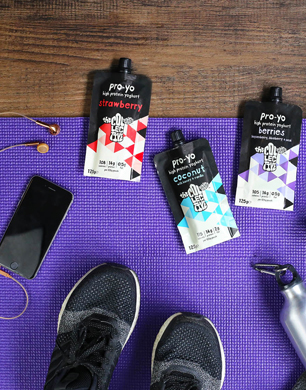
1. What is protein?
“Protein is one of three essential macronutrients that our bodies need to survive (the other two are carbohydrates and fat). Some of the main sources of protein are foods like meat, fish, dairy (including yoghurt!) and some vegetables.”
2. Why do you need it?
“Protein is crucial for building and repairing muscle tissue. Without it, our bodies can’t form or rebuild muscles, making it essential for exercise. If you’re exercising to get lean or build muscle, the process involves first breaking muscle tissue down so that they can rebuild as stronger, better versions of themselves. Even if you’re not a fitness fanatic, consuming a diet rich in protein is essential for everything from a strong immune system to healthy hair, skin and nails, as well as backing-up your energy supplies.”
3. The best sources of protein
Animal-based proteins
Nutritionists describe animal-based proteins as ‘complete’ sources of protein, because they tick off all nine essential amino acids that your body needs in one go.
Here are my top three sources: Yoghurt – it contains all nine essential amino acids as well as probiotic bacteria, which is great for creating and maintaining a happy tummy.
Yoghurt – it contains all nine essential amino acids as well as probiotic bacteria, which is great for creating and maintaining a happy tummy.
100g of natural yoghurt contains up to 5g of protein. Pro-yo, the new high-protein yoghurt pouch from The Collective, contains around 11.7g of protein per 100g serving (and each pouch contains 14g of protein!)”
Chicken breast – not only a lean meat, one chicken breast contain at least 25g of protein. Plus, chicken is rich in lots of minerals like calcium and phosphorus which helps keep bones healthy.
100g of chicken breast contains 33g of protein.
Eggs – most of the vitamins, minerals and antioxidants in eggs are found in the yolk, but the egg whites also contain at least 60% of the protein.
1 egg contains about 6g of protein.
Many of the proteins found in plants contain essential amino acids, but not as many that’s found in animal-based proteins. It’s best to mix-and-match different sources of plant-based proteins as you can to ensure your body isn’t missing out on any crucial amino acids.
Here are my top three plant-based protein sources:
Tofu – as well as being a great source of plant-based protein, tofu also contains a healthy dose of fats, carbs and a variety of vitamins and minerals.
100g tofu typically contains 10-19g of protein.
Lentils – high in fibre, magnesium, potassium, iron, folate, copper, manganese and various other nutrients basically means that lentils are a true superfood, and one of the world’s best sources of plant-based protein.
100g of cooked lentils contains up to 9g of protein.
Chickpeas – high in fibre and protein, chickpeas are great for digestive health and are known to help blood sugar regulation.
100g of cooked chickpeas contain up to 9g of protein.
4. How much should I eat?
The average UK adult should eat 0.75g of protein daily for each kilogram they weigh (based on the Reference Nutrient Intake, or RNI).
So, if you weigh 70kg (11 stone), you’ll need about 52.5g of protein each day.
If you’re a super-fit gym bunny, first of all – go you! Secondly, you’ll need a bit more protein in your diet to make up for all that hard work you’re putting your body through. As a general rule, it’s good to aim to eat at least 1g of protein per kilogram of body weight over the course of your day.
It’s all very well telling someone they need to consume 50g of protein, but what does this actually look like as a portion? There is a handy rule-of-thumb to go by: the protein-palm. 50g of protein is roughly a palm-sized portion of meat, dairy, fish, tofu or nuts.
In other words, that’s roughly…
2 large chicken breasts,
8 large eggs plus
Almost 2 cans of chickpeas!
… or 3.5 Pro-Yo pouches!
Rhiannon Lambert, Registered Harley Street Nutritionist, working on the launch of the new high protein yoghurt pouch Pro-yo, from The Collective.

